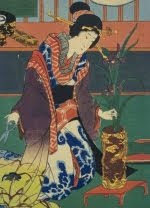Not everyone will agree that art must be born out of pain. It has to be heartfelt though. And the creative process may require that you give your utmost.
"The Flower of Pain".
Chrysanthemum, Steel grass,
Gladiolus.
In this ikebana arrangement I have used dying branches with black bark, cut into small pieces and put together with nails to create a rather compact Hana dome, a flower fixture that becomes an integrated part of the arrangement. Dark red Chrysanthemum and two more vivid red Gladiolus gives the colour.
This is my interpretation of the rather dramatic woodcut "The Flower of Pain" (1898) by Edvard Munch. The artist is kneeling on the ground with his upper body twisted in pain, blood pouring out of his heart. Out of the soil that is soaked in his blood grows a lily. The flower nourished by the blood symbolizes art forcing it's way as a necessity of life.

This is the last ikebana arrangement from the series inspired by Munch's art that I made earlier this summer for an exhibition at Oslo Rose Days. I hope you have enjoyed them. The exhibition takes place every summer in the Freia Hall, an integrated part of the Freia chocolate factory in Oslo. The walls of the hall are covered with large paintings by Munch. This hidden gem of art is now to be sold, so this might be our last year.













